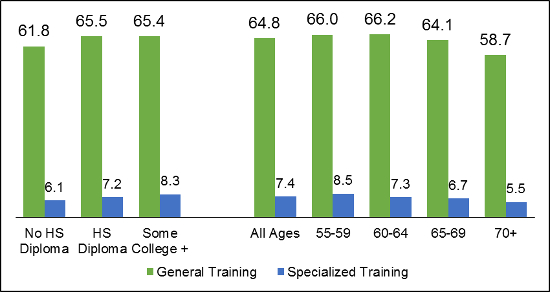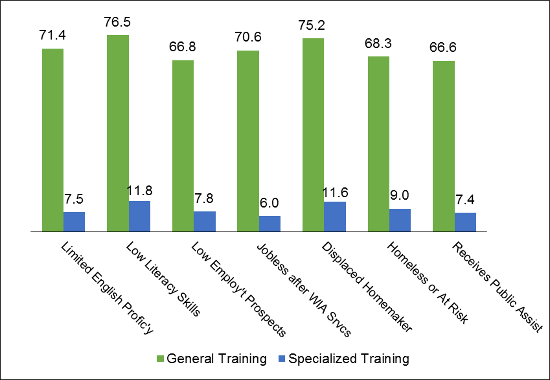
 The American workforce is graying; by 2022, more than 25 percent of workers will be over 55. These shifts in the age structure of the workforce mean that education and training programs will become more important for older workers in the coming years. In new research, Phyllis Cummins and Bob Harootyan find that older workers on lower incomes and those who are unemployed are less likely to participate in adult education and training programs. They write that such training for older workers could be encouraged via publicly sponsored employment and training programs, tax incentives for employers to provide training, and programs to better inform older workers education and training opportunities and their benefits.
The American workforce is graying; by 2022, more than 25 percent of workers will be over 55. These shifts in the age structure of the workforce mean that education and training programs will become more important for older workers in the coming years. In new research, Phyllis Cummins and Bob Harootyan find that older workers on lower incomes and those who are unemployed are less likely to participate in adult education and training programs. They write that such training for older workers could be encouraged via publicly sponsored employment and training programs, tax incentives for employers to provide training, and programs to better inform older workers education and training opportunities and their benefits.
The aging of the baby boomer cohort has had a dramatic impact on the makeup of the US labor force. Of the projected labor force in 2022, workers aged 55 and over will comprise 25.6 percent, up from 11.8 percent in 1992. For several decades, labor force participation rates (LFPR) have increased for both the 55-64 and 65-74 age groups. Increases in the female LFPR have been especially dramatic, projected to climb from 46.5 percent in 1992 to 64.3 percent in 2022 for the 55-64 age group and from 12.5 percent to 28.3 percent for women aged 65-74.
Shifts in the age structure of the US labor force, combined with the increased LFPRs among older adults, require policies and programs that encourage and support employment at older ages. In new research, we analyzed data from two sources to better understand training programs for older adults that facilitate paid employment. First, we used data from the US Department of Labor (DOL) to analyze the training experiences of participants in the Senior Community Service Employment Program (SCSEP). Second, we used US data from the Program for the International Assessment of Adult Competencies (PIAAC) to examine the relationship between participation in adult education and training (AET) programs and employment outcomes for persons aged 45-65. AET includes training available in the workplace, publicly sponsored training programs and training initiated by an individual. We find that some age groups of older people who are unemployed are less likely to participate in AET, and that for all ages over 45, lower incomes are also linked to lower levels of participation in adult education and training programs.
Senior Community Service Employment Program
SCSEP is the only federally sponsored workforce development program specifically designed to provide unemployed low-income adults ages 55+ with work-based training opportunities and is one of the few national programs of its kind among industrialized countries. In Program Year 2013, SCSEP served about 68,000 participants with a budget of $434.4 million (75 percent of which must be used for participants’ wages and benefits). The special national administrative dataset from DOL contained over 68,000 unduplicated records of community service assignments (CSAs). Every CSA is a part-time, temporary job-training assignment with a host agency. For this analysis, training other than the CSA is categorized as “general” or “specialized.” General training includes group meetings where participants learn about job search strategies, local employment resources, and other helpful information. Specialized training involves career tracking, which may include classroom or individual instruction necessary for a specific employment goal. Notably, SCSEP has no line-item funding specifically for training other than the CSA.
We analyzed the extent of participation in training among subgroups of participants. In PY2013, other than the CSA, 64.8 percent of participants received general training and 7.4 percent had specialized training. As Figure 1 indicates, the proportions receiving specialized training were highest for those aged 55-59, decreasing slightly for each of the older age groups.
Figure 1 – Type of SCSEP Training Received, by Education and Age Group (percent)

Participants aged 70+ were significantly less likely to receive general or specialized training. Training experiences increase with participants’ educational attainment. The higher the participant’s educational level, the more likely s/he received specialized training (see Figure 1). This may reflect greater need for special skills updating among better educated participants, whose employment goals are more likely to be at the managerial and professional job levels compared to participants with less education.
SCSEP’s mission, which includes serving those who are “most in need,” is reflected in its PY2013 participants’ characteristics: 19 percent had less than a high school diploma, 88 percent had family incomes at or below the federal poverty level, 87 percent had low employment prospects, and 19 percent had low literacy. Further reflecting that mission, our results for receipt of general vs. specialized training indicate that participants with low literacy, displaced homemakers, and the homeless are more likely to receive specialized training compared to other subgroups (see Figure 2).
Figure 2 – Type of SCSEP Training Received, by Selected Characteristics (percent)

Low participation in adult education and training among unemployed older people and those on lower incomes
The Program for the International Assessment of Adult Competencies (PIAAC) is an international survey organized by the Organisation for Economic Cooperation and Development (OECD) and conducted in the US in 2011-2012, consists of an extensive background questionnaire and an assessment that scores participants in literacy, numeracy, and problem-solving skills. Data from the background questionnaire, which includes basic demographic statistics along with information on participation in various types of adult education and training programs, employment and income, were used to analyze the relationship between participation in adult education and training programs (AET) and employment and income. To provide an adequate sample size to assess the benefits of AET for middle-aged and older adults, we focused on adults aged 45-65. Of 5,010 US participants, 1,084 were aged 45-54 and 1,066 were aged 55- 65.
Overall AET participation rates were 55.8 percent for the 45-54 age group and 50.4 percent for the 55-65 age group. However, the 45-54 age group’s participation rates were significantly lower for the unemployed as compared to the employed — only 29.9 percent of the unemployed group participated in AET, compared to 64.5 percent for the employed group. Low participation rates by the unemployed are of concern because they may require additional training to become reemployed. The unemployed often rely on publicly sponsored training programs, but their lack of awareness of these services, combined with low funding levels, are potential causes for low participation rates. For the 55-65 age group, there was no significant relationship between participation in AET and employment status.
AET participation is strongly related to income level. For both age groups, there was a significant relationship between AET participation and income quintile. Among those aged 45- 54, 47.4 percent of the lowest income quintile participated in AET compared to 83.4 percent of the highest income quintile. The results were similar for the 55-65 age group: 50.5 percent of the lowest income quintile participated in AET compared to 77.4 percent of the highest income quintile (see Figure 3).
Figure 3 – AET Participation by Income Quintile and Age Group (percent)

Note: Second and fourth quintiles are not shown.
Older workers are less likely to participate in both publicly and employer sponsored training as compared to younger workers. Analyses of PIAAC data suggest that lower-income groups and the unemployed could benefit from increased opportunities to participate in AET programs. This could be accomplished in many ways, including increased funding for SCSEP (including a separate line item for special training) and other publicly sponsored employment and training programs, tax incentives for employers to provide AET, and support for programs to better inform older workers about AET opportunities and their benefits.
This article is based on the paper, ‘Workforce Development in the United States: Facilitating Opportunities to Work at Older Ages’, in Public Policy & Aging Report.
Featured image
: Ken Russell (Flickr, CC-BY-NC-SA-2.0)
Please read our comments policy before commenting.
Note: This article gives the views of the author, and not the position of USAPP – American Politics and Policy, nor the London School of Economics.
Shortened URL for this post: http://bit.ly/1mKssFM
_________________________________
 Phyllis Cummins – Miami University, Ohio
Phyllis Cummins – Miami University, Ohio
Phyllis Cummins is the Assistant Director of Research and a Research Scholar at Scripps Gerontology Center, Miami University, Ohio. Dr. Cummins’ research focuses on strategies that will allow older adults to remain in the workforce at older ages. She recently co-authored a paper commissioned by the American Institutes for Research that used PIAAC data to analyze outcomes for older adults who participated in adult education and training.
 Bob Harootyan – Senior Service America
Bob Harootyan – Senior Service America
Bob Harootyan is Manager of Research at Senior Service America, Inc., the third largest grantee of the US federal Senior Community Service Employment Program. Bob has more than four decades of experience in applied and policy-related research in academia, state government, the US Congress, and national non-profit organizations. Bob’s research has focused on disadvantaged elders, the aging workforce, technology and digital literacy, and productive aging. He is a Fellow of the Gerontological Society of America.




1 Comments